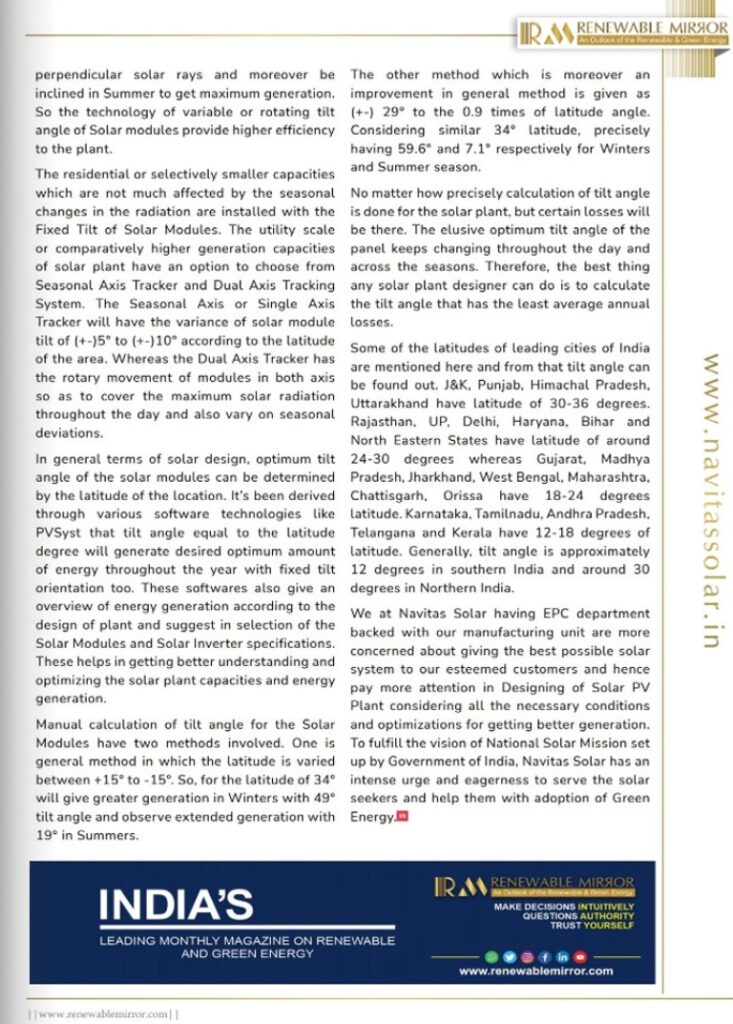Sunay Shah Explains Solar System Orientation in Renewable Mirror
Indian Government is encouraging Green Growth as witnessed in Budget 2023. Solar energy will see exponential growth in upcoming years leaving fossil fuels behind. Key component in solar energy is solar modules, orientation and positioning of the module in the plant also play a major role in maximizing energy yield. The more surface area of the module is exposed to the sun, the more energy can be harvested. Solar module is generally fixed while sun moves around in the sky which makes maximizing energy yield a bit difficult. Correct orientation and positioning give assurance that solar modules get access to the sun throughout the day.
There are many aspects to keep in mind while installing a solar power plant like available open space, location of the plant, orientation of the plant, tilt of the plant etc. India is a lucky country to have 300 sunny days throughout the year. Some states are indeed lucky to have ample amount of sunlight throughout the year like Rajasthan, Gujarat etc. The direction of installing solar power plant is also an important aspect while designing the system. Basically, it totally depends on which region the plant needs to be installed on the earth. If the plant needs to be installed in Northern hemisphere, panels are installed facing south and if the plant needs to be installed in Southern Hemisphere, then North facing of the panels is preferred. This is because in northern hemisphere, north side of a building will always be in the shade. In the morning, east is lit up by the sun and west is shaded and, in the evening, west is lit by the sun and east is shaded. So, the sun has a southern offset in northern hemisphere and a northern offset in southern hemisphere.
This is because the sun follows a different path in the sky during winters and summers and that’s why ideal tilt angle is never fixed. As a thumb rule, solar panels should be more vertical during winter as sunlight will have to pass though more atmosphere to reach the panels and panels should be more tilted during summer to maximize the output as the sun is positioned higher in the sky during the summer so it has to travel less distance to reach earth’s surface.
To harness the maximum power from solar, the solar modules need to be tilted by ±5°/10° depending on latitude. It is called as seasonal tracking. This is often carried out manually in residential solar systems but for utility scale solar plants, this can be achieved by mechanical devices. The best way to harness maximum amount of electricity from solar is to track sun’s path throughout the day and from season to season. It’s called as dual axis tracking. In larger solar power plants, this technology is more prominent.
India falls in Northern Hemisphere, so mostly sun is available directly over south facing panels. So, thumb rule in India is to set up solar panels in south facing direction. North and East directions in India can also work well but the direction to avoid solar plant’s facing is North.
Another factor to consider in solar plant installation is tilt angle of the solar plant. The Solar panel tilt angle is the angle between the horizontal ground and solar modules. The tilt angle is decided base on the location (latitude and longitude) of the plant. Tilt angle can be decided by knowing exact latitude of the plant location. It is believed that modules placed at a tilt angle equivalent to the latitude of the location can produce maximum output. A solar tracking system can also be installed to harness maximum energy output. Nowadays, many softwares are helpful in solar plant design like PVsyst, Autocad, Sketchup, PVsol, SAM etc.
Calculation of tilt angle can be done by two methods. Method 1 is adding 15 degrees to latitude during winters and subtracting 15 degrees from latitude during summers. For example, if the latitude of the location is 34 degrees, then the optimum tilt angle for winter is 49 degrees and optimum tilt angle during summer is 19 degrees. This is general method.
Another method is improvement of general method which gives better results. In this method, optimum tilt angle during winter is calculated by multiplying latitude by 0.9 and then adding 29 degrees. From above example, (34*0.9) +29=59.6. In this method, the optimum tilt angle is 10 degrees steeper than general method. To find optimum tilt angle during summers, latitude is multiplied by 0.9 and then subtracted by 29 degrees. (34*0.9)-23.5=7.1 degrees.
No matter how precisely calculation of tilt angle is done for the solar plant, but certain losses will be there. The elusive optimum tilt angle of the panel keeps changing throughout the day and across the seasons. Therefore, the best thing any solar plant designer can do is to calculate the tilt angle that has the least average annual losses.
Some of the latitudes of leading cities of India are mentioned here and from that tilt angle can be found out. J&K, Punjab, Himachal Pradesh, Uttarakhand have latitude of 30-36 degrees. Rajasthan, UP, Delhi, Haryana, Bihar and North Eastern States have latitude of around 24-30 degrees whereas Gujarat, Madhya Pradesh, Jharkhand, West Bengal, Maharashtra, Chattisgarh, Orissa have 18-24 degrees latitude. Karnataka, Tamilnadu, Andhra Pradesh, Telangana and Kerala have 12-18 degrees of latitude. Generally, tilt angle is approximately 12 degrees in southern India and around 30 degrees in Northern India. Tilt angle affects Ground Coverage Ratio (GCR) because tilted modules occupy less space. New trend is Time of Use (TOU) pricing. In this system, energy charges are higher for peak time. In this time, already active power plants are stretched to its limits to supply electricity to the grid. Customers pay out more money to pay their electricity bills under TOU. In places like this, a study says that west facing panels are more economical compared to south or north as west facing panels generate 49% more electricity during peak hours.
Renowned Solar provider Navitas Solar considers all the factors while designing a solar power plant. With Navitas Solar, it will be easy for the solar seekers in India to move forward in adopting green energy, contributing to the National Solar Mission.




 Online | Privacy policy
Online | Privacy policy
Related Posts
You May Also Like
Bonito Series: Driving Innovation in…
Read MoreTOPCon Series: The Next Generation…
Read MoreValuable Points to Remember During…
Read MoreNavitas Planet Partners with Hysolwin…
Read MoreDriving Towards a Sustainable Future:…
Read MoreWhy Do Top-Grade EVA Sheets…
Read MoreBonito Series: Driving Innovation in…
Read MoreTOPCon Series: The Next Generation…
Read MoreValuable Points to Remember During…
Read MoreNavitas Planet Partners with Hysolwin…
Read MoreDriving Towards a Sustainable Future:…
Read MoreWhy Do Top-Grade EVA Sheets…
Read MoreBonito Series: Driving Innovation in…
Read MoreTOPCon Series: The Next Generation…
Read MoreValuable Points to Remember During…
Read MoreNavitas Planet Partners with Hysolwin…
Read More